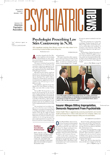No one, least of all health care professionals, wants patients to be harmed by the care that is meant to help them. Recent national attention to patient safety has demonstrated that patients are harmed during the course of treatment more often than is acceptable. The recognition of the need to improve patient safety has prompted much discussion and the development of initiatives by national and local stakeholders seeking to reduce preventable adverse medical events. APA’s Committee on Patient Safety has taken the lead in patient safety initiatives for psychiatry (see “The APA Task Force on Patient Safety: Recommendations to the APA Board of Trustees,” which is posted at www.psych.org/pract_of_psych/apa_patientsafety_toc21003.pdf).
Improving patient safety involves preventing problems by identifying errors, analyzing the causes of preventable adverse events, and developing better processes and systems to prevent those problems. Interestingly, this is a description of the risk management process. Risk management has always supported prevention and improving quality—key factors in patient safety. Promoting patient safety also reduces professional liability risk, another goal of risk management. The risk management process is a tool that health care professionals can use to support patient safety efforts.
But where does one start to make changes to improve patient safety? It is impossible to implement every bit of risk management advice that well-meaning risk managers promote. Using the risk management process helps make decisions about where and how to expend finite resources for improving patient safety and reducing professional liability risk.
There are five steps to the risk management process:
Step 1: Identify current and potential risks
APA’s Committee on Patient Safety has identified three priority areas for improving patient safety: adverse medication events, safe use of seclusion/restraints, and reduction of suicides in inpatient/residential settings. Other current or potential risks to patient safety in psychiatric treatment settings can be identified, but it makes sense to focus on those risks found to be of high frequency and/or high severity.
Step 2: Evaluate risks (frequency and severity)
Data from psychiatric malpractice lawsuits reveal that patient suicide or suicide attempts are the most frequent identifiable cause of such lawsuits. Patient suicide is a relatively high frequency and high severity risk. Adverse medication events are another high frequency risk, according to information from psychiatric malpractice lawsuits. The severity of this risk ranges from very high (death or permanent disability) to relatively low (an error that results in minimal injury and resolves without residual impairment). Recent concentrated efforts to decrease the use of seclusion/restraint make this patient safety risk less frequent; however, the severity can range from very high, as evidenced by reported cases of patient deaths, to less severe injuries.
Step 3: Choose a risk management strategy
Plans to improve patient safety and reduce professional liability risk can take many forms depending on the type of practice, amount of resources, the treatment team available, and so on.
In the last issue of Psychiatric News, Al Herzog, M.D., chair of APA’s Committee on Patient Safety, gave several suggestions about how psychiatrists in office practice can approach patient safety. Future articles about patient safety and risk management in this publication will focus on each of the three identified risk areas and discuss additional risk strategies learned from evaluating psychiatric malpractice lawsuits. Below are a few examples:
• Patient suicide: A review of these cases sometimes reveals a less-than-thorough assessment of potential suicide risk. Psychiatrists should find a good guideline for assessing suicide risk, incorporate it into their practice, and use it consistently. Incorporating such a system into a practice supports a “culture of safety.” Competent and caring clinicians can make mistakes; designing good systems and work processes will reduce mistakes.
• Adverse medication events: Psychiatrists should set up a reminder system that provides an alert when necessary laboratory testing needs to be ordered for a patient.
• Know your environment: Psychiatrists should read the restraint/seclusion policies and procedures at the facilities where they affiliate and understand the facility’s requirements and their responsibilities under these policies.
Step 4: Implement the strategy
Psychiatrists should start with selected strategies that have the most potential to impact the most significant patient safety issues identified. Don’t try to change everything at once; small changes are more likely to be sustained and can be built upon. Focus on improving systems and processes that support patient safety.
Step 5: Evaluate the strategy
After a reasonable trial, psychiatrists can decide whether the chosen strategy works for their practice and then modify or implement another strategy as needed.
Sometimes clinicians approach risk management with an air of paranoia, convinced that they must adopt a siege mentality and practice “defensive medicine” to reduce professional liability risk. But this is a mistaken impression. When used appropriately, the application of risk management principles and strategies helps a psychiatric practice run more smoothly and reduces anxiety by supporting the quality of care provided to patients—all contributing to improved patient safety. ▪
